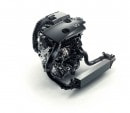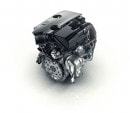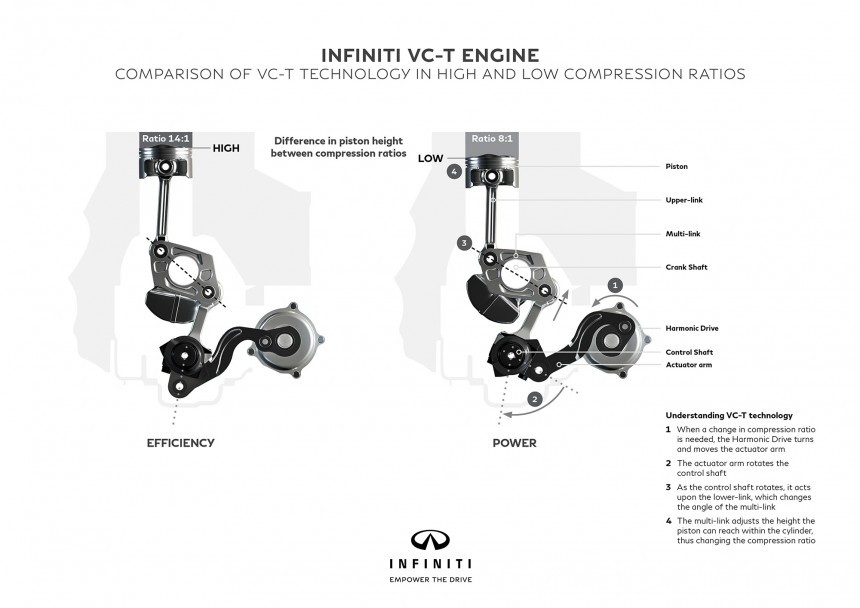As a concept, the internal combustion engine is as old as dirt. To our luck, the ICE is still relevant nowadays thanks to engineering developments such as direct injection, cylinder deactivation, stop & start, the whole nine yards. Despite that, the internal combustion engine is like a Nokia in a world of iPhones.
I am one of those people who want to believe that the ICE and electric revolution can live together as one. But the truth of the matter is, electricity is getting more and more appealing than suck-squeeze-bang-blow. Despite these trends the industry finds itself in, Japanese automaker Infiniti rolled up its sleeves and got to work. After many years of research and development, the world’s first production-ready variable compression ratio engine is ready.
The peeps at Mercedes-Benz and Saab have played with the idea of variable compressions ratio in the DiesOtto and SVC. Those two forerunners of the Infiniti VC-T haven’t got into production, though. “The what?” The Infiniti Variable Compression [dash] Turbo. Slated to make its public outing at the Paris Motor Show, the engine has four cylinders and God knows how many liters. The Japanese manufacturer is coy on displacement, yet it does mention that this thing here “delivers the power of a high-performance 2.0-liter turbo gasoline engine with a high level of efficiency at the same time."
Other than the fact it can adjust its compression ratio between 8:1 for high performance and 14:1 for maximum efficiency, the Infiniti VC-T can adjust its displacement. But how does it do that? Well, it so happens that the pistons aren’t connected to the crankshaft.
In this application, Infiniti went for a pivot arm with a connection at each end. The first of the two ends is connected to the piston, while the second is connected to a second lower shaft, which is controlled by an actuator arm. While the pistons move up and down according to the crankshaft’s lobes, the actuator arm mentioned earlier is able to change the angle of the pivot arm. Are you still with me? Good.
When the actuator arm moves the pivot up, there’s less room at the top, equaling a higher compression ration. When the pivot arm is in its lowest position, the compression ratio goes down. But that’s not all there is to this engine. The second lower shaft eliminates the need for counter-rotating balance shafts as you might find on a regular internal combustion engine.
The electronic variable valve timing system, on the other hand, can switch the revolutionary engine developed by Infiniti into Atkinson-cycle combustion when the situation calls for it. Other highlights include the integration of port and direct fuel injection, an exhaust manifold integrated into the cylinder head, an electronic wastegate control, and a variable-displacement oil pump.
I know what you’re thinking, and you’re right. The Infiniti VC-T is a very serious piece of kit which is seriously different from the ICEs we’re accustomed to. The first Infiniti model to use this engine is the all-new generation of the QX50 crossover, which is due to start production in 2017.
For more information on the Infiniti VC-T engine, check out the following release and patent application publication.
The peeps at Mercedes-Benz and Saab have played with the idea of variable compressions ratio in the DiesOtto and SVC. Those two forerunners of the Infiniti VC-T haven’t got into production, though. “The what?” The Infiniti Variable Compression [dash] Turbo. Slated to make its public outing at the Paris Motor Show, the engine has four cylinders and God knows how many liters. The Japanese manufacturer is coy on displacement, yet it does mention that this thing here “delivers the power of a high-performance 2.0-liter turbo gasoline engine with a high level of efficiency at the same time."
In this application, Infiniti went for a pivot arm with a connection at each end. The first of the two ends is connected to the piston, while the second is connected to a second lower shaft, which is controlled by an actuator arm. While the pistons move up and down according to the crankshaft’s lobes, the actuator arm mentioned earlier is able to change the angle of the pivot arm. Are you still with me? Good.
When the actuator arm moves the pivot up, there’s less room at the top, equaling a higher compression ration. When the pivot arm is in its lowest position, the compression ratio goes down. But that’s not all there is to this engine. The second lower shaft eliminates the need for counter-rotating balance shafts as you might find on a regular internal combustion engine.
The electronic variable valve timing system, on the other hand, can switch the revolutionary engine developed by Infiniti into Atkinson-cycle combustion when the situation calls for it. Other highlights include the integration of port and direct fuel injection, an exhaust manifold integrated into the cylinder head, an electronic wastegate control, and a variable-displacement oil pump.
I know what you’re thinking, and you’re right. The Infiniti VC-T is a very serious piece of kit which is seriously different from the ICEs we’re accustomed to. The first Infiniti model to use this engine is the all-new generation of the QX50 crossover, which is due to start production in 2017.
For more information on the Infiniti VC-T engine, check out the following release and patent application publication.






